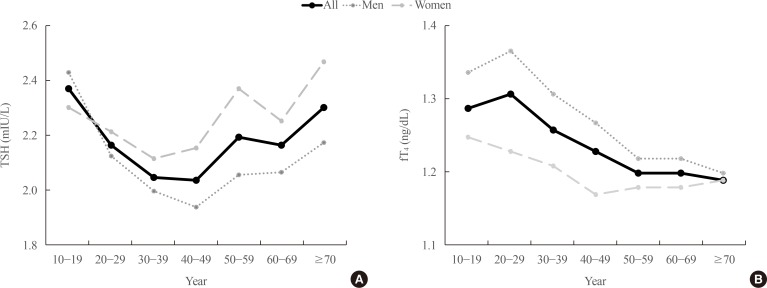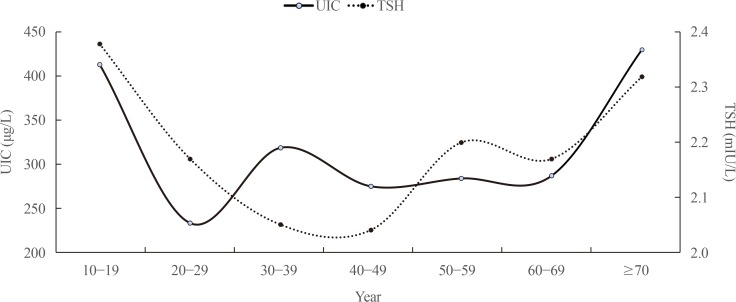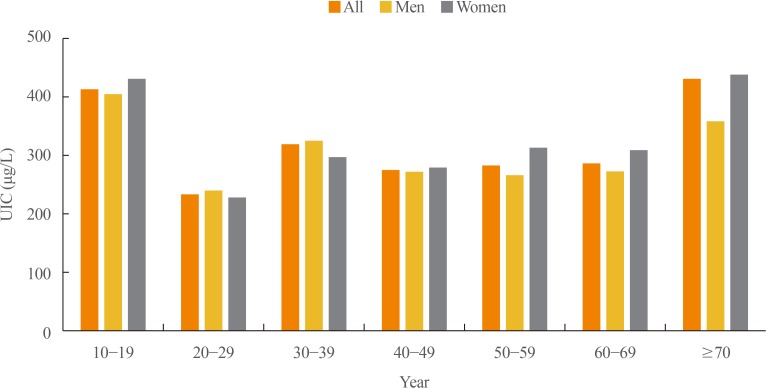Update on Thyroid Hormone Levels and Thyroid Dysfunction in the Korean Population Based on Data from the Korea National Health and Nutrition Examination Survey VI (2013 to 2015)
- Affiliations
-
- 1Division of Endocrinology and Metabolism, Department of Medicine and Thyroid Center, Samsung Medical Center, Sungkyunkwan University School of Medicine, Seoul, Korea. thyroid@skku.edu
- KMID: 2471715
- DOI: http://doi.org/10.3803/EnM.2020.35.1.7
Abstract
- In 2017, the first Korean nationwide data on serum thyroid stimulating hormone (TSH) levels, serum free thyroxine (fT4) levels, and urinary iodine concentration (UIC) were published based on a population of 7,061 Koreans who participated in the Korea National Health and Nutrition Examination Survey VI. The mean TSH level was 2.16 mIU/L, with a reference interval of 0.59 to 7.03 mIU/L (men 2.09 mIU/L, women 2.24 mIU/L, P<0.001). A U-shaped association was found between serum TSH levels and age. The mean fT4 level was 1.25 ng/dL, and its reference interval was 0.92 to 1.60 ng/dL (men 1.29 ng/dL, women 1.20 ng/dL, P<0.0001). Serum fT4 levels decreased with age (P for trend <0.0001). Serum thyroid peroxidase antibody (TPOAb) was detected in 7.30% of participants (men 4.33%, women 10.62%). TPOAb titers tended to increase with age, and were higher in women than in men. The median UIC was 294 µg/L, and UIC showed a U-shaped relationship with age. According to the World Health Organization recommendations, only 23% of participants were in the adequate range of iodine intake, while 65% were in the above requirements or excessive, and 12% in insufficient. The prevalence of overt hyperthyroidism and hypothyroidism in Koreans was 0.34% to 0.54% and 0.73% to 1.43%, respectively.
Keyword
MeSH Terms
Figure
Cited by 4 articles
-
Subclinical Hypothyroidism: Prevalence, Health Impact, and Treatment Landscape
Won Sang Yoo, Hyun Kyung Chung
Endocrinol Metab. 2021;36(3):500-513. doi: 10.3803/EnM.2021.1066.Association between Iodine Intake, Thyroid Function, and Papillary Thyroid Cancer: A Case-Control Study
Kyungsik Kim, Sun Wook Cho, Young Joo Park, Kyu Eun Lee, Dong-Wook Lee, Sue K. Park
Endocrinol Metab. 2021;36(4):790-799. doi: 10.3803/EnM.2021.1034.Exploring the Association between Thyroid Function and Frailty: Insights from Representative Korean Data
Youn-Ju Lee, Min-Hee Kim, Dong-Jun Lim, Jung-Min Lee, Sang Ah Chang, Jeongmin Lee
Endocrinol Metab. 2023;38(6):729-738. doi: 10.3803/EnM.2023.1769.Reference Standards for C-Peptide in Korean Population: A Korean Endocrine Hormone Reference Standard Data Center Study
Jooyoung Cho, Ho-Chan Cho, Ohk-Hyun Ryu, Hyo-Jeong Kim, Chang Geun Kim, Young Ran Yun, Choon Hee Chung
Endocrinol Metab. 2024;39(3):489-499. doi: 10.3803/EnM.2023.1888.
Reference
-
1. Chung JH. Evaluation of thyroid hormone levels and urinary iodine concentrations in Koreans based on the data from Korea National Health and Nutrition Examination Survey VI (2013 to 2015). Endocrinol Metab (Seoul). 2018; 33:160–163. PMID: 29766681.
Article2. Hollowell JG, Staehling NW, Flanders WD, Hannon WH, Gunter EW, Spencer CA, et al. Serum TSH, T(4), and thyroid antibodies in the United States population (1988 to 1994): National Health and Nutrition Examination Survey (NHANES III). J Clin Endocrinol Metab. 2002; 87:489–499. PMID: 11836274.
Article3. Chaker L, Korevaar TI, Medici M, Uitterlinden AG, Hofman A, Dehghan A, et al. Thyroid function characteristics and determinants: the Rotterdam study. Thyroid. 2016; 26:1195–1204. PMID: 27484151.
Article4. Baloch Z, Carayon P, Conte-Devolx B, Demers LM, Feldt-Rasmussen U, Henry JF, et al. Laboratory medicine practice guidelines: laboratory support for the diagnosis and monitoring of thyroid disease. Thyroid. 2003; 13:3–126. PMID: 12625976.5. Kim WG, Kim WB, Woo G, Kim H, Cho Y, Kim TY, et al. Thyroid stimulating hormone reference range and prevalence of thyroid dysfunction in the Korean population: Korea National Health and Nutrition Examination Survey 2013 to 2015. Endocrinol Metab (Seoul). 2017; 32:106–114. PMID: 28116874.
Article6. Park SY, Kim HI, Oh HK, Kim TH, Jang HW, Chung JH, et al. Age- and gender-specific reference intervals of TSH and free T4 in an iodine-replete area: data from Korean National Health and Nutrition Examination Survey IV (2013-2015). PLoS One. 2018; 13:e0190738. PMID: 29390008.
Article7. Kwon H, Kim WG, Jeon MJ, Han M, Kim M, Park S, et al. Age-specific reference interval of serum TSH levels is high in adolescence in an iodine excess area: Korea National Health and Nutrition Examination Survey Data. Endocrine. 2017; 57:445–454. PMID: 28762216.
Article8. Jeon MJ, Kim WG, Kwon H, Kim M, Park S, Oh HS, et al. Excessive iodine intake and thyrotropin reference interval: data from the Korean National Health and Nutrition Examination Survey. Thyroid. 2017; 27:967–972. PMID: 28471294.
Article9. Kang TS, Leem DG, Seo IW, Lee YJ, Yoon TH, Lee JH, et al. Monitoring of iodine in foods for estimation of dietary intake [Internet]. Cheongju: National Institute of Food and Drug Safety Evaluation;2012. cited 2020 Feb 3. Available from: file:///C:/Users/USER/Downloads/OA2014_Z4_0250.pdf.10. Medici M, Visser WE, Visser TJ, Peeters RP. Genetic determination of the hypothalamic-pituitary-thyroid axis: where do we stand? Endocr Rev. 2015; 36:214–244. PMID: 25751422.
Article11. Joung JY, Cho YY, Park SM, Kim TH, Kim NK, Sohn SY, et al. Effect of iodine restriction on thyroid function in subclinical hypothyroid patients in an iodine-replete area: a long period observation in a large-scale cohort. Thyroid. 2014; 24:1361–1368. PMID: 24892764.
Article12. Park S, Kim WG, Jeon MJ, Kim M, Oh HS, Han M, et al. Serum thyroid-stimulating hormone levels and smoking status: data from the Korean National Health and Nutrition Examination Survey VI. Clin Endocrinol (Oxf). 2018; 88:969–976. PMID: 29604104.
Article13. Choi J, Kim HS, Hong DJ, Lim H, Kim JH. Urinary iodine and sodium status of urban Korean subjects: a pilot study. Clin Biochem. 2012; 45:596–598. PMID: 22391027.
Article14. Lee J, Kim JH, Lee SY, Lee JH. Iodine status in Korean preschool children as determined by urinary iodine excretion. Eur J Nutr. 2014; 53:683–688. PMID: 23881585.
Article15. International Council for Control of Iodine Deficiency Disorders. UNICEF. World Health Organization. Assessment of iodine deficiency disorders and monitoring their elimination: a guide for programme managers. 3rd ed. Geneva: World Health Organization;2007.16. Chung JH. Low iodine diet for preparation for radioactive iodine therapy in differentiated thyroid carcinoma in Korea. Endocrinol Metab (Seoul). 2013; 28:157–163. PMID: 24396673.
Article17. Kim HI, Oh HK, Park SY, Jang HW, Shin MH, Kim SW, et al. Urinary iodine concentration and thyroid hormones: Korea National Health and Nutrition Examination Survey 2013-2015. Eur J Nutr. 2019; 58:233–240. PMID: 29188371.
Article18. Kim JY, Kim KR. Dietary iodine intake and urinary iodine excretion in patients with thyroid diseases. Yonsei Med J. 2000; 41:22–28. PMID: 10731915.
Article19. Rhee SS, Braverman LE, Pino S, He X, Pearce EN. High iodine content of Korean seaweed soup: a health risk for lactating women and their infants? Thyroid. 2011; 21:927–928. PMID: 21745110.
Article20. Zou Y, Lou X, Ding G, Mo Z, Zhu W, Mao G. A cross-sectional comparison study on the iodine nutritional status between rural and urban residents in Zhejiang Province, China. BMJ Open. 2014; 4:e005484.
Article21. Aghini-Lombardi F, Vitti P, Antonangeli L, Fiore E, Piaggi P, Pallara A, et al. The size of the community rather than its geographical location better defines the risk of iodine deficiency: results of an extensive survey in Southern Italy. J Endocrinol Invest. 2013; 36:282–286. PMID: 23712195.
Article22. Choi YC, Cheong JI, Chueh HW, Yoo JH. Iodine status and characteristics of Korean adolescents and their parents based on urinary iodine concentration: a nationwide cross-sectional study. Ann Pediatr Endocrinol Metab. 2019; 24:108–115. PMID: 31261475.
Article23. Seo GH, Kim SW, Chung JH. Incidence & prevalence of hyperthyroidism and preference for therapeutic modalities in Korea. J Korean Thyroid Assoc. 2013; 6:56–63.
- Full Text Links
- Actions
-
Cited
- CITED
-
- Close
- Share
- Similar articles
-
- Evaluation of Thyroid Hormone Levels and Urinary Iodine Concentrations in Koreans Based on the Data from Korea National Health and Nutrition Examination Survey VI (2013 to 2015)
- Urinary Iodine Concentration and Thyroid Peroxidase Antibodies in the Korean Population Using Korea National Health and Nutrition Examination Survey VI
- Letter: Thyroid Stimulating Hormone Reference Range and Prevalence of Thyroid Dysfunction in the Korean Population: Korea National Health and Nutrition Examination Survey 2013 to 2015 (Endocrinol Metab 2017;32:106-14, Won Gu Kim et al.)
- Response: Thyroid Stimulating Hormone Reference Range and Prevalence of Thyroid Dysfunction in the Korean Population: Korea National Health and Nutrition Examination Survey 2013 to 2015 (Endocrinol Metab 2017;32:106-14, Won Gu Kim et al.)
- Thyroid Stimulating Hormone Reference Range and Prevalence of Thyroid Dysfunction in the Korean Population: Korea National Health and Nutrition Examination Survey 2013 to 2015




